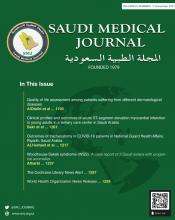Original Articles
Quality of life assessment among patients suffering from different dermatological diseases
AlOtaibi et al assess the quality of life (QoL) of patients with different dermatological diseases. Multiple international studies have evaluated the QoL among patients with different dermatological diseases; however, few studies of this kind is conducted in Saudi Arabia. A self-administered questionnaire is distributed to participants. The questionnaire is divided into 3 sections. The first section collects demographic information, such as gender, age, and marital status. The second section gathers data on the participant’s dermatological disease, including diagnosis, time since diagnosis, type and duration of treatment, and any other comorbid diseases. The third section consists of the validated Arabic version of the Dermatology of Life Quality Index, and it is used in the study with permission. They conclude that understanding the impact of different dermatological diseases on patients’ QoL can help dermatologists to improve their patients’ QoL. The study shows that dermatological diseases have variable impact on patients’ QoL.
see page 1195
Clinical profiles and outcomes of acute ST-segment elevation myocardial infarction in young adults in a tertiary care center in Saudi Arabia
Sakr et al investigate the clinical profiles and outcomes of young adults presenting with ST-segment elevation myocardial infarction (STEMI). In total, 402 patients are enrolled; 197 are younger than 45 years. The incidence of newly diagnosed dyslipidemia is higher in younger patients. Smoking is significantly more prevalent in the younger group. The prevalence of pulmonary edema and cardiogenic shock on presentation is significantly higher in the older group. Hospital stay is also longer in the older group. They concluded that STEMI in young patients has a favorable outcome. Smoking and dyslipidemia are the main risk factors for STEMI in young individuals and the majority of young patients with dyslipidemia are not aware of their pre-existing condition.
see page 1201
Lipid profile and length of hospital stay for patients younger and older than 45 years.
Outcomes of tracheostomy in COVID-19 patients in National Guard Health Affairs, Riyadh, Saudi Arabiasection, in a referral center in Saudi Arabia
ALHumaid et al evaluate coronavirus disease 2019 (COVID-19) patient tracheostomy outcomes. All COVID-19 patients at the National Guard Hospital, Riyadh, Saudi Arabia, are retrospectively recruited. The population is 45 patients, of which 30 are males, 15 are females and the mean age is 66.76±12.74 years. The tracheostomy indications are anticipated prolonged weaning in 40 and failed extubation in 5 patients. The mean intubation to tracheostomy duration is 20.62±7.21 days. Mortalities are high, with most attribute to COVID-19. Mortality and a pre-tracheostomy C-reactive protein (CRP) uptrend are significantly related. Mortality and intubation to tracheostomy duration are not significantly related. The mean post-tracheostomy time to death is 10.64±6.9 days. They concluded that the high mortality rate is attribute to COVID-19. Mortality and a pre-tracheostomy CRP uptrend are significantly related; uptrend patients experience far more mortalities than downtrend patients. Unlike previous findings, mortality and intubation to tracheostomy duration are not significantly related.
see page 1217
Case Report
Woodhouse-Sakati syndrome (WSS)
Alharbi discusses the case of 3 Saudi sisters having Woodhouse-Sakati syndrome (WWS). It is a rare genetic condition of autosomal recessive inheritance pattern. The disease is characterized by a group of disorders, including diabetes mellitus, alopecia, hypogonadism, intellectual disability, and progressive extrapyramidal signs. This syndrome is related to an inherited neurodegenerative disorder’s heterogeneous group characterized by the accumulation of iron in the brain, caused by a mutation in the DCAF17 gene. The 3 sisters aged 18, 22, and 25 years took birth to consanguineous parents. The sisters initially have normal developmental growth with deprived scholastic performance because of the intellectual difficulties. At puberty, the secondary sexual characteristics are not developed in the patients, and they face primary amenorrhea. They are found to have features typical of WSS, but they also have gynecological anomalies, which are considered unusual findings in WSS patients.
see page 1237
Magnetic resonance imaging for the brain of case number 1.
- Copyright: © Saudi Medical Journal
This is an Open Access journal and articles published are distributed under the terms of the Creative Commons Attribution-NonCommercial License (CC BY-NC). Readers may copy, distribute, and display the work for non-commercial purposes with the proper citation of the original work.








